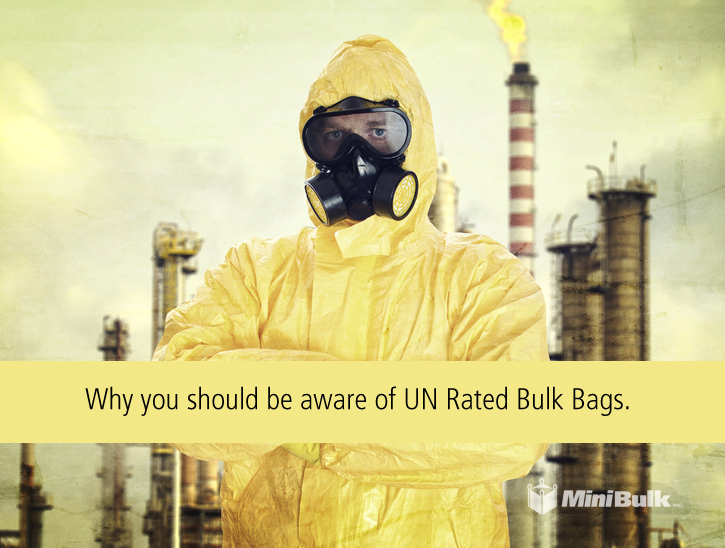For those of you who missed that headline, I am referring to the Department of Transportation, Transport Canada, the United Nations, and MiniBulk.
What do we all have in common? We all work together to minimize the risk associated with transporting volatile and toxic substances.
When it comes to transporting regulated materials, there are guidelines and laws designed to protect people, flora, fauna, and our waterways. Accidental spilling of toxic substances into our environment can have lasting effects on every living thing near the spill site. A spill of your material costs time and money, and can negatively affect your company brand.

Why you should be aware of UN Rated Bulk Bags.
As an individual or company, you need to be keenly aware of all rules and regulations pertaining to the hazardous material you are transporting. The United Nations publishes the "Orange Book" a Globally Harmonized System of Classification and Labeling of Chemicals (GHS) and the UN Recommendations on the Transport of Dangerous Goods (get the PDF here).
The Orange Book is an invaluable resource, and if you are often transporting regulated materials, you should familiarize yourself with it.
What is a UN Rated Bulk Bag?
A UN rated bulk bag is an FIBC that has been designed and tested to meet a higher standard of durability than a regular bulk bag. The industry standard for a regular FIBC is a safety ratio of 5:1.
That is, when our regular 1,000 kg bags are manufactured, they are put through a test that applies increasing pressure into a filled bag while suspended from the loops. A large metal plate presses down into the bag and that bag cannot fail until at least 5,000 kgs of force has been exerted.
That is impressive, but not as impressive as the standard 6:1 safety ratio required for UN rated bags! These heavy duty bulk bags are designed and tested to ensure the hazardous materials remain inside the bag even under excessively difficult conditions.
Why a UN Rated Bulk Bag?
In addition to the higher safety ratio, UN bags are also put through a full set of rigorous testing before they can be approved and registered with the authorities. Some of the extra testing they go through include:
- Drop Test – The bags are filled to the maximum permissible capacity with the weight evenly distributed. Then the bags are dropped from a height that corresponds to the packing group. The bag cannot burst or allow product to escape when dropped.
- Topple Test - Similar to the drop test, the bags are set on a platform with the maximum permissible capacity. Instead of dropping straight down, the bags are toppled over from the side from a height corresponding to their packing group. Again, the bag cannot burst or leak.
- Righting Test – The bags are filled to the maximum permissible capacity and then knocked over on to their side. The bag is then righted into proper position by only 2 loops. The bag and loops should not show any sign of damage once righted.
- Top Lift Test – The bags are once again filled to the maximum capacity and suspended by the lifting loops. A hydraulic cylinder is forced down into the bags and they must maintain a total load of six times the permissible capacity for a period of five minutes.
- Stacking Test – A filled bag is placed on a flat surface and a uniformly superimposed pressure is applied to the top of the bag that would equal the number of similar bags stacked on top. A 2,205 lb bag being stacked 3 high would have to endure 7,920 lbs for a period of 24 hours to pass.
- Tear Test – A bag is filled to the maximum permissible capacity and then cut by a knife in a 100 mm long slash at a 45 degree angle. The tear is not to expand in size or leak when a superimposed load equal to double the capacity of the bag is applied for five minutes.
If the bags fail any of these tests, they will not be recognized by the authorities and we cannot legally label them as UN Rated bags. On top of the testing parameters that must be met, there is an expiry date on UN Certification as well.
UN Rated Bulk Bag Applications
MiniBulk currently stocks 3 styles of UN Rated bags in our Calgary warehouse. There is an unlined bag, a bag with a built-in liner, and hardwall version for various applications.
The unlined UN bag can be combined with two, 6 mil liners to be in compliance with regulations for transporting and disposing of asbestos. The UN bag with a built in 4 mil liner is ideal for containing and transporting items such as hydrocarbon contaminated items like rags and soil. Finally we carry a UN Rated bag that can stand up on its own without a racking system. This design is ideal for remote cleanup sites and smaller jobs.

If you have a minor spill and you need to remove a couple cubes of soil, no need to call in massive and expensive equipment. Just get the rookies on your team a couple shovels and the hardwall bag. A few good scoops and the contaminated soil is ready to be sent for remediation. All three of our designs belong to Packing Group II, the middle rating of hazardous goods.
Cracking the UN Code
The easiest way to spot a UN bag is to look for the UN string printed on the side. Every FIBC will bear markings that are durable, legible, at least 12mm in height and readily visible.
A UN certificate is valid for 3 years and must be renewed 3 months prior to expiration. Here is an example of a UN string and what each code represents moving left to right.
UN 13H4 / Y / mmyy / CAN / Minibulk 4-537 / 1800 / 1000
UN 13H4 is the UN code. H4 = a woven plastic, coated bag and with a liner. Here are the four options you can see printed on the side of a UN bag referring to bag construction:
- H1 woven plastic without coating or liner
- H2 woven plastic; coated
- H3 woven plastic with liner
- H4 woven plastic, coated and with a liner
Y = Packing Group II. There are three packing groups used to classify products in UN rated bulk bags (X, Y and Z). Most bulk bags will fall into the packing group II category, medium danger. Packing group I is the most dangerous material while packing group III is the least dangerous. For example, a double walled cardboard box can meet UN standards for packing group III.
Next in the string we have mmyy, simply the date of manufacture. The next item is CAN, the Country Code associated with that particular design. Next is Minibulk 4-537. This is very important as it represents the company who commissioned the UN testing and the Transport Canada Certificate of registration. 1800 is the stack load test result we discussed previously, and the final 1000 represents the safe working load. If you were paying attention earlier, you know that 1000 kgs has a safety ratio of 6:1 instead of the standard 5:1.
Learn More about UN Rated HazMat Bags
If you are in the environmental business, it would be wise to read up on UN ratings and how they apply to your business. UN Rated bulk bags can help you achieve your project goals in a safe and efficient manner. The UN code on each bag design is unique, so you should have different UN codes for your different sizes and styles of UN rated bags. If you are using multiple UN rated bags at your facility, and they all have the same UN code printed on them, you better have a conversation with your current supplier. Better yet, you should have a conversation with us.


